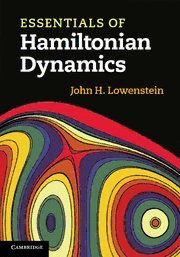
Essentials of Hamiltonian Dynamics PDF
Preview Essentials of Hamiltonian Dynamics
ESSENTIALS OF HAMILTONIAN DYNAMICS Classicaldynamicsisoneofthecornerstonesofadvancededucationinphysicsand appliedmathematics,withapplicationsacrossengineering,chemistry,andbiology. In this book, the author uses a concise and pedagogical style to cover all the topics necessary for a graduate-level course in dynamics based on Hamiltonian methods. Readers are introduced to the impressive advances in the field during the second half of the twentieth-century, including KAM theory and determinis- tic chaos. Essential to these developments are some exciting ideas from modern mathematics, which are introduced carefully and selectively. Core concepts and techniques are discussed, together with numerous concrete examples to illustrate key principles. A special feature of the book is the use of computer software to investigatecomplexdynamicalsystems,bothanalyticallyandnumerically. This text is ideal for graduate students and advanced undergraduates who are already familiar with the Newtonian and Lagrangian treatments of classical mechanics.Thebookiswellsuitedtoaone-semestercourse,butiseasilyadapted to a more concentrated format of one-quarter or a trimester. A solutions man- (cid:2) ual and introduction to Mathematica are available online at www.cambridge. org/Lowenstein. JOHN H. LOWENSTEIN is Professor Emeritus of Physics at New York Universityandhasbeenconductingresearchinnonlineardynamicsformorethan 20 years. Prior to that, his research focus was in quantum field theory with an emphasisonsolublemodelsandrenormalizedperturbationtheory. ESSENTIALS OF HAMILTONIAN DYNAMICS JOHN H. LOWENSTEIN DepartmentofPhysics,NewYorkUniversity CAMBRIDGE UNIVERSITY PRESS Cambridge,NewYork,Melbourne,Madrid,CapeTown, Singapore,SãoPaulo,Delhi,Tokyo,MexicoCity CambridgeUniversityPress TheEdinburghBuilding,CambridgeCB28RU,UK PublishedintheUnitedStatesofAmericabyCambridgeUniversityPress,NewYork www.cambridge.org Informationonthistitle:www.cambridge.org/9781107005204 (cid:2)c J.H.Lowenstein2012 Thispublicationisincopyright.Subjecttostatutoryexception andtotheprovisionsofrelevantcollectivelicensingagreements, noreproductionofanypartmaytakeplacewithoutthewritten permissionofCambridgeUniversityPress. Firstpublished2012 PrintedintheUnitedKingdomattheUniversityPress,Cambridge AcatalogrecordforthispublicationisavailablefromtheBritishLibrary ISBN978-1-107-00520-4Hardback Additionalresourcesforthispublicationatwww.cambridge.org/Lowenstein. CambridgeUniversityPresshasnoresponsibilityforthepersistenceor accuracyofURLsforexternalorthird-partyinternetwebsitesreferredto inthispublication,anddoesnotguaranteethatanycontentonsuch websitesis,orwillremain,accurateorappropriate. ToMarcia Contents Preface pagexi 1 Fundamentalsofclassicaldynamics 1 1.1 Newtonianmechanics 1 1.2 Configurationspace 2 1.2.1 Particleonasphere 2 1.2.2 Planardoublependulum 2 1.2.3 Independenceofconstraints 4 1.2.4 Configurationspaceasadifferentialmanifold 5 1.3 LagrangianformulationofNewtonianmechanics 7 1.4 Hamiltonianformulation 8 1.4.1 IntroductionoftheHamiltonian 8 1.4.2 Phasespace 10 1.5 Examples 11 1.5.1 Harmonicoscillator 11 1.5.2 Simplependulum 11 1.5.3 Exactsolutionofthependulumequations 14 1.5.4 Abeadonarotatingcircle 15 1.5.5 Sphericalpendulum 18 1.5.6 Rigidbodywithonepointfixed 21 Exercises 26 2 TheHamiltonianformalism 29 2.1 ThePoissonbracket 29 2.2 Canonicaltransformations 30 2.3 Simpleexamples 32 2.4 CanonicalinvarianceofLagrangebrackets 32 2.5 Generatingfunctionsforcanonicaltransformations 34 2.6 Canonicalinvarianceofphase-spacevolume 38 vii viii Contents 2.7 Covariance of Hamilton’s equations with explicit time dependence 39 2.8 Continuousone-parametergroupsofcanonicaltransformations 40 2.9 TheHamiltonianformulationofelectrodynamics 42 2.10 Normalmodesforlinearoscillators 44 Exercises 54 3 Integrablesystems 56 3.1 TheLiouville–Arnol’dtheorem 56 3.2 Fasttrackforseparablesystems 57 3.3 Systemwithonedegreeoffreedom 60 3.4 TheKeplerprobleminsphericalpolarcoordinates 61 3.5 ProofoftheLiouville–Arnol’dtheorem 64 3.6 Planarfree-particleexamples 69 3.6.1 Atwo-dimensionalfreeparticle,model1 70 3.6.2 Atwo-dimensionalfreeparticle,model2 71 3.6.3 Circularstadiumbilliard 73 3.7 Sphericalpendulum 78 3.8 Thethree-particleTodamodel 85 Exercises 91 4 Canonicalperturbationtheory 97 4.1 Generalapproach 97 4.2 Simplependulumrevisited 98 4.3 Twoharmonicoscillatorswithquarticcoupling 102 4.4 Gyratingchargeinanelectrostaticwave 104 4.5 Birkhoff–Gustavsonperturbationtheory 109 4.6 AformalsecondintegralfortheHénon–Heilesmodel 110 4.7 IntegrabilityanalysisofHénon–Heiles-likesystems 112 Exercises 115 5 OrderandchaosinHamiltoniansystems 121 5.1 Nonlinearstability 122 5.2 TheKAMtheorem 122 5.3 NonlinearstabilityoftheLagrangepoints 127 5.4 Kickedoscillators 129 5.5 Lyapunovexponents 136 5.6 Web-mapLyapunovexponents 138 5.7 Amodelofachaoticallyrotatingmoon 139 Exercises 142 6 Theswing-spring 148 6.1 Two-dimensionalmotion 149 Contents ix 6.2 Integrableapproximationsforsmalloscillations 152 6.3 Threecommutingintegrals 154 6.4 Dynamicsonthelevelsets 156 6.5 Constraintsamongtheintegrals 158 6.6 Flowcoordinatesandtheperiodlattice 165 6.7 Monodromy 168 6.8 Periodicshiftoftheswingplane 172 6.9 Theswing-springinmolecularmodeling 176 Exercises 177 (cid:2) Appendix Mathematica samples 178 A.1 Numericalintegrationofequationsofmotion 178 A.2 Hyperionmovie 179 A.3 Simplependulumperturbationtheory 181 A.4 Birkhoff–Gustavsonperturbationtheory 181 References 184 Index 186
